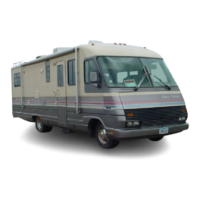Vehicle Response
When you, the driver, accelerate, brake or steer the motor
home,
it
responds to these inputs.
If
you are faced with
an emergency while driving, the way you respond to the
emergency and the way the motor home responds
becomes more critical.
If
you load, alter or maintain your
motor home improperly, it will not respond as it did
when you first received it in an unloaded condition.
Improper loading, alteration, maintenance
and
improp-
er
driver responses to emergency conditions can lead to
handling problems
and
vehicle crashes.
Vehicle Towing
Your motor home can be equipped with a hitch designed
to allow you to tow vehicles or other loads behind your
motor home. The maximum amount
of
weight your
motor home can pull or stop is determined by the
manu-
facturer
of
the chassis on which your motor home is built.
Check the
Chassis Operator's/Owner's Guide/Manual
provided by the motor home chassis manufacturer for the
limits on the weight you can
tow.
If
the Chassis Operator's/Owner's Guide/Manual does not
provide information on towing weight limits, do not tow a load
of more than 1000 pounds unless the towed unit has a
prop-
erly installed and operating supplemental brake control sys-
tem that operates with the brakes on your motor home.
»
You
may be able to increase the weight of any towed load
by
properly installing on the towed load a supplemental
brake control system that operates with your motor home's
braking system. Even with additional brakes, you cannot
tow more than the GTW or GCWR for the chassis under
your motor home. Again, check the
Chassis
Operator's/Owner's Guide/Manual.
»
You
CANNOT increase the towed weight limit
by
changing
the size of your hitch.
» Properly load what you tow to avoid a vehicle crash.
PACE
Annow
INTROduCTioN
01,11

